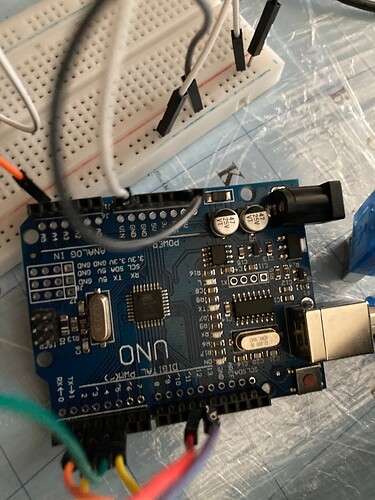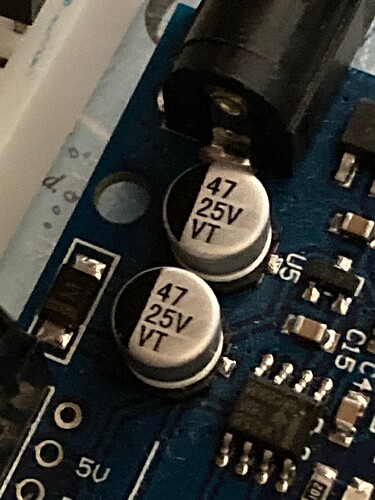so i was planning to use my arduino from the barrel jack dc and i have a wall adaptor that convert 242 volts Ac to 6 Volts 200mA that apparently has 1.2VA which is 1.2 Volt-Amps
here's the photo: ( by the way i live in Turkey)
IIRC, you need at least seven volts.
The Arduino will only take as much current as it requires. You cannot feed it too much current
However, 6V is not really enough to use the barrel jack because there is a voltage regulator after it in the circuit to drop the voltage to 5V used by the Arduino and a larger voltage differential is needed for the regulator to work
It may be worth giving the power supply a try as its output may be higher than stated and no harm will be caused if it is not. Note that even if the Arduino works with the power supply then I would not rely on it as its output may drop below what is required as the load increases
Have you got a mobile 'phone charger with an output of 5V ? If so then you can feed 5V directly to a 5V pin on the Arduino
but The real question is how much VA(volt-amps) could an arduino take and also the only power brick that is 200mA or0.2A that i have
how much power the built-in voltage regulator can burn. The higher the input voltage the less current is possible before the regulator shuts off for current or temperature exceeded.
will my arduino shut down as i understood from what you said?
My Arduino Uno with nothing else connected is running at just-under 60mA. (Two of the built-in LEDs are on.)
ok but would an 200ma (miliamp)could do it? and im also using an arduino klon or clone
I think that you did not understand voltage and current. You apply a voltage and the Arduino takes as much current as required. Increasing the unregulated voltage has no effect on the current.
It will shut down if it deserves more current than your PSU can supply.
It appears that the real question is how much current does an Arduino need rather than how much it could handle
Meanwhile, back at the question of supplying the correct voltage ...
Some basic electronics -
There is a common analogy between water flow and electrical current flow, where voltage is similar to water pressure. A skinny pipe is resistance and a fat pipe has less resistance.
It's not a perfect analogy because when you cut a pipe you have zero resistance and water flows-out all over place, whereas if you cut a wire you have infinite resistance and no electrical current flows. Also, nothing bad happens with zero water resistance (except maybe a flood ![]() ) but with zero electrical resistance (AKA a "short circuit") you get excess current and "bad things" happen.
) but with zero electrical resistance (AKA a "short circuit") you get excess current and "bad things" happen.
So resistance is "the resistance to current flow".
Ohm's Law defines the relationship between Voltage, Resistance and Current as:
Current = Voltage / Current. If you take an electronics class this is the 1st thing you learn.
In most situations voltage is (almost) constant. Your 240V power outlets ALWAYS have 240V available. If nothing is plugged-in no current flows. If you plug-in (and turn-on) a 100W light bulb, a little less than 1/2 Amp will flow, If you plug-in a toaster or hair drier about 5A will flow. If you plug-in too many things too much current will flow and you'll blow your circuit breaker and then voltage drops to zero.
Power (Watts) is calculated as Voltage X Current.
It's basically the same as VA except that there can be phase shifts where voltage & current are out-of-phase (they don't peak at the same time) and in this case the actual power/energy consumed will be less than the VA. In most cases we can use Watts and VA interchangably.
We don't generally know the resistance of a light bulb or the Arduino but we could calculate it.
With the Arduino its current & resistance can change... When you turn-on an LED, more current is drawn so resistance is going down, etc.
The voltage regulator is essentially a variable resistance... If you are powering through the barrel jack (using the built-in regulator) the current to the board has to go through the regulator (with a small amount of additional current "used" by the regulator). It's supplying constant voltage to all of the other components on the board which means if you increase the voltage, the regulator automatically adds series resistance to keep the current constant.
With higher voltage into the regulator, the power supply has to supply more power (V x A) and that extra power is wasted as heat in the voltage regulator.
Higher current also means more power wasted in the voltage regulator. If you try to power a motor through the built-in voltage regulator, that current through the regulator will overheat it and the regulator will shut-down,
The amount of heat depends on the voltage dropped across the regulator and the current through it. For example, if you have 12V and 1A total that's 12 Watts with 5W going to the main circuitry and 7W wasted in the regulator (and it will overheat).
The onboard regulator is a linear regulator which works like a variable resistor. A switch mode regulator (DC-DC converter) "converts" the power without wasting as much power so in general a switch mode regulator runs cooler and it can handle more current,
i have 12 V 1.5 Amp adaptor but i dont wanna fry my arduino like last time
What did you do last time that fried the Arduino ?
12V into the barrel jack is OK. Not ideal as it wastes power but it will work. 1.5 Amps is enough for a basic Uno
Make sure that the barrel connector of the power supply is centre positive and do not use it if it isn't
150mA @ 12V is enough, the voltage regulator does not allow for higher current. 250mA @ 9V, 500mA @ 7V.
Oh dear. No wonder that it didn't end well, but which Arduino has a 3.5V pin ? Do you mean the 3.3V pin ?
The Uno barrel jack will work with 7V to 12V DC, centre pin positive so your 12V supply (the first picture) should be OK
yeah i meant 3.3 also wouldnt 1.5A be 1500mA? btw is this the regulator?
the capacitor looking thing?
also im using an lcd circuit so that should be ok?
Yes, 1.5A is 1,500 millamps. So what ?
The capacitor looking things are capacitors
If the LCD display is powered from the Arduino 5V or 3.3V pin then you should be OK. The Arduino is not intended to be used as a power supply for things such as motors but for small, less power hungry components it is OK to use its 5V and/or 3.3V outputs
As long as you don't exceed 12V input and the supply is of the correct polarity then you should be safe to use the barrel connector but it is not ideal as power is wasted converting the voltage to a lower one
I assume that your project works OK with power from USB, the current from which is itself limited, and that you now want to use it not connected to teh PC
i have a usb powerbank which turns off after 10 secs and i want to use it with barrel jack because i never did that before and why would i bring a Lightning to usb OTG with me and my iphone just to power up an arduino? also isn't the maximum amperage limit is 200mA? and which one is the regulator? I also have 1 port off. because of the cooler and mouse. and it's only 1 so if i wanna use my gamepad and also use my arduino i have to use my arduino only or my gamepad only and i'm planning to buy an usb hub






